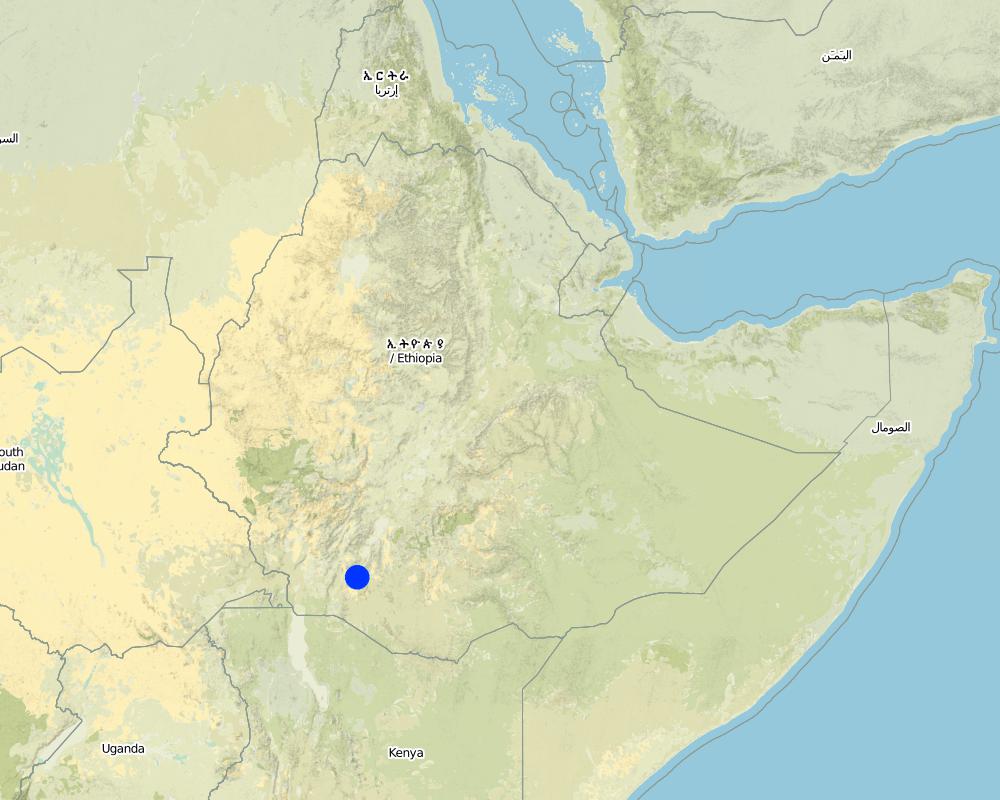Ridge & Basin [埃塞俄比亚]
- 创建:
- 更新:
- 编制者: Unknown User
- 编辑者: –
- 审查者: Fabian Ottiger, Alexandra Gavilano
Monna (Konso Language)
technologies_979 - 埃塞俄比亚
查看章节
全部展开 全部收起1. 一般信息
1.3 关于使用通过WOCAT记录的数据的条件
编制者和关键资源人员接受有关使用通过WOCAT记录数据的条件。:
是
2. SLM技术的说明
2.1 技术简介
技术定义:
It is a rectangular shaped soil embankment created in digging up sol and farming ridge and a basin for harvesting moisture.
2.2 技术的详细说明
说明:
It is rectangular soil embankment made with local implement called 'Bayra' and maintained every three years during dry season. The technology is applied on moderately deep soils. It is intended for moisture harvesting. Establishment is made by visual survey and then the soil excavated using local implement and maintained wherever there is a need for maintenance. Low and erratic nature of rainfall, shallow to moderately deep soils and medium textured soils are some of the governing factors for the technology.
2.5 已应用该技术的、本评估所涵盖的国家/地区/地点
国家:
埃塞俄比亚
区域/州/省:
SNNPR
Map
×2.6 实施日期
如果不知道确切的年份,请说明大概的日期:
- 50多年前(传统)
2.7 技术介绍
详细说明该技术是如何引入的:
- 作为传统系统的一部分(> 50 年)
注释(项目类型等):
It is practiced since long time by the Konso Tribes
3. SLM技术的分类
3.2 应用该技术的当前土地利用类型

农田
- 一年一作
- 多年一作(非木材)
年作 - 具体指明作物:
- 谷类 - 高粱
- 纤维作物 - 棉花
- 豆科牧草和豆类 - 豆子
- 豆科牧草和豆类 - 豌豆
- pigeon peas
每年的生长季节数:
- 2
具体说明:
Longest growing period in days: 150 Longest growing period from month to month: Mar - Jul Second longest growing period in days: 120 Second longest growing period from month to month: Aug - Dec
采用间作制度了吗?:
是
注释:
Major land use problems (compiler’s opinion): land shortage, pest, high price of inputs, low rainfall and erratic nature
Major land use problems (land users’ perception): land shortage, pest, low rainfall
Type of cropping system and major crops comments: inter cropping
3.4 供水
该技术所应用土地的供水:
- 雨养
3.5 该技术所属的SLM组
- 集水
3.6 包含该技术的可持续土地管理措施

结构措施
- S4:平沟、坑
注释:
Main measures: structural measures
Secondary measures: vegetative measures
Type of agronomic measures: mixed cropping / intercropping, contour ridging
3.7 该技术强调的主要土地退化类型

土壤水蚀
- Wt:表土流失/地表侵蚀

水质恶化
- Ha:干旱化
注释:
Main type of degradation addressed: Ha: aridification
Secondary types of degradation addressed: Wt: loss of topsoil / surface erosion
Main causes of degradation: other natural causes (avalanches, volcanic eruptions, mud flows, highly susceptible natural resources, extreme topography, etc.) specify, poverty / wealth (Lack of captial)
Secondary causes of degradation: other human induced causes (specify) (Agricultural causes), labour availability (Lack of labour)
4. 技术规范、实施活动、投入和成本
4.1 该技术的技术图纸
技术规范(与技术图纸相关):
Technical knowledge required for land users: moderate
Main technical functions: Moisture harvesting
Secondary technical functions: control of dispersed runoff: retain / trap, increase / maintain water stored in soil
Mixed cropping / intercropping
Material/ species: Sorghum,pigeon peas, cotton, beans
Contour ridging
Material/ species: layout is on nearly contour and accrose the slope. The ridges are mostly rectangular with 3x2, 4x3m
Gradient along the rows / strips: 0.00%
4.2 有关投入和成本计算的一般信息
其它/国家货币(具体说明):
Ethiopian Birr
如相关,注明美元与当地货币的汇率(例如1美元=79.9巴西雷亚尔):1美元=:
8.5
注明雇用劳工的每日平均工资成本:
0.65
4.3 技术建立活动
| 活动 | 时间(季度) | |
|---|---|---|
| 1. | Land preparation | dry season |
| 2. | Planting | onset of rain |
| 3. | Weeding | rainy season |
| 4. | Lay out | dry season |
| 5. | Soil excavation | dry season |
4.4 技术建立所需要的费用和投入
注释:
Duration of establishment phase: 12 month(s)
4.5 维护/经常性活动
| 活动 | 时间/频率 | |
|---|---|---|
| 1. | Land preparation | |
| 2. | Planting of sorghum | |
| 3. | Planting of cotton | |
| 4. | Planting of pigeon peas | |
| 5. | Planting of beans | |
| 6. | Soil excavation | dry season/each cropping season |
| 7. | Soil excavation | dry season/each cropping season |
4.6 维护/经常性活动所需要的费用和投入(每年)
注释:
Per ha of land treated
4.7 影响成本的最重要因素
描述影响成本的最决定性因素:
Labour, farm implement, soil workability and surface stoniness
5. 自然和人文环境
5.1 气候
年降雨量
- < 250毫米
- 251-500毫米
- 501-750毫米
- 751-1,000毫米
- 1,001-1,500毫米
- 1,501-2,000毫米
- 2,001-3,000毫米
- 3,001-4,000毫米
- > 4,000毫米
农业气候带
- 半干旱
5.2 地形
平均坡度:
- 水平(0-2%)
- 缓降(3-5%)
- 平缓(6-10%)
- 滚坡(11-15%)
- 崎岖(16-30%)
- 陡峭(31-60%)
- 非常陡峭(>60%)
地形:
- 高原/平原
- 山脊
- 山坡
- 山地斜坡
- 麓坡
- 谷底
垂直分布带:
- 0-100 m a.s.l.
- 101-500 m a.s.l.
- 501-1,000 m a.s.l.
- 1,001-1,500 m a.s.l.
- 1,501-2,000 m a.s.l.
- 2,001-2,500 m a.s.l.
- 2,501-3,000 m a.s.l.
- 3,001-4,000 m a.s.l.
- > 4,000 m a.s.l.
5.3 土壤
平均土层深度:
- 非常浅(0-20厘米)
- 浅(21-50厘米)
- 中等深度(51-80厘米)
- 深(81-120厘米)
- 非常深(> 120厘米)
土壤质地(表土):
- 中粒(壤土、粉土)
表土有机质:
- 中(1-3%)
- 低(<1%)
如有可能,附上完整的土壤描述或具体说明可用的信息,例如土壤类型、土壤酸碱度、阳离子交换能力、氮、盐度等。:
Soil fertility is low. Also very low - medium
Soil drainage/infiltration is good
Soil water storage capacity is medium/low
5.6 应用该技术的土地使用者的特征
非农收入:
- 低于全部收入的10%
相对财富水平:
- 贫瘠
- 平均水平
机械化水平:
- 手工作业
说明土地使用者的其他有关特征:
Population density: 10-50 persons/km2
Annual population growth: 2% - 3%
60% of the land users are average wealthy and own 60% of the land.
25% of the land users are poor and own 35% of the land.
20% of the land users are poor and own 5% of the land.
Off-farm income specification: No considerable difference
Level of mechanization: Manual labour (Animal traction is hindered as a result of the ridge and basin structures. It means that only hoe cultivation is possible)
5.8 土地所有权、土地使用权和水使用权
土地所有权:
- 个人,有命名
土地使用权:
- 个人
6. 影响和结论性说明
6.4 成本效益分析
技术收益与技术建立成本相比如何(从土地使用者的角度看)?
短期回报:
稍微积极
长期回报:
非常积极
技术收益与技术维护成本/经常性成本相比如何(从土地使用者的角度看)?
短期回报:
积极
长期回报:
非常积极
6.5 技术采用
在所有采用这项技术的人当中,有多少人是自发的,即未获得任何物质奖励/付款?:
- 0-10%
注释:
100% of land user families have adopted the Technology with external material support
Comments on acceptance with external material support: estimates
There is a strong trend towards spontaneous adoption of the Technology
Comments on adoption trend: The technology started over 400 years ago and it is already part of the farming systems.
7. 参考和链接
7.1 信息的方法/来源
链接和模块
全部展开 全部收起链接
无链接
模块
无模块


